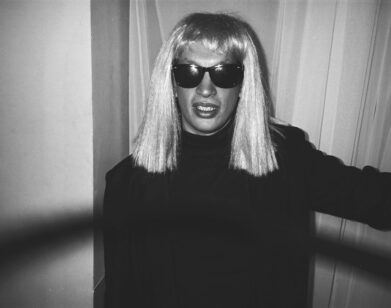See Terry O’Neill’s rare images of David Bowie’s last show as Ziggy Stardust
In October 1973, British photographer Terry O’Neill received a call from then-manager Tony Defries to shoot an artist by the name of David Bowie—someone he had no idea would go on to become a music superstar, trailblazing style icon, and above all, close friend. The no-holds-barred performance was to be the last appearance of Bowie’s electric alter ego, Ziggy Stardust.
O’Neill, known to music circles for getting his pictures in the newspaper, was there to capture the bittersweet farewell. An exhilarated audience of friends and fans gathered at The Marquee in London to take one last trip to Mars with Ziggy and The Spiders. O’Neill couldn’t keep his shutter clicking fast enough with Bowie’s warped, dynamic performance. Almost 50 years later, the 79-year-old photographer has gathered all his best shots—for the first time—in When Ziggy Played the Marquee, breathing new life into an otherworldly presence so dearly missed.
Being a musician helped O’Neill—also a jazz drummer at the time—forge close relationships with the subjects he photographed, who have ranged from Elton John to Frank Sinatra to The Beatles and among them, the late Bowie. “I treated him as an actor more than a singer, it was really like being in the theater when he worked,” he says about the artist’s elaborate stage productions. O’Neill worked with Bowie on many of his projects, photographing the artwork for his 1974 album Diamond Dogs as well as behind shooting behind the scenes of his sci-fi film The Man Who Fell to the Earth with Nicolas Roeg.
O’Neill’s book features never before seen photos he took that day, accompanied by stories of the people who got to experience Ziggy for the very last time. “There’s never been anyone like him,” he says. Though he left too soon, Ziggy’s explosive energy is forever frozen, captured by Terry O’Neill at his last show at the Marquee.
HAVING ALL ACCESS
O’NEILL: The only other person like him who is great to photograph and gave me all that access was Frank Sinatra. That was mostly because I was friendly with Ava Gardner and she wrote a letter to Frank to introduce me. If Bowie had something interesting going on in his life, he’d ring me up and say, “I’ve got somebody coming to the office, I’d love if you could take a picture.” That’s how I took a picture of him with William Burroughs. I didn’t know who Burroughs was when I took the picture, but I soon found out when it was published in Rolling Stone [laughs.]
BACKSTAGE BOWIE
It’s a small club, the Marquee, it’s not a big place. So I could just do what I liked there. It was packed with people, so I had to work through the people. I had a lot of help from Angie, his wife at the time. She was a big influence on him at the time. She always helped me when I was working with him. She didn’t push him around but she used to keep everyone away from him and organized everything. She kept the show going, so to speak. She was like a stage manager. Backstage, Bowie was very quiet, kept to himself. He spent a lot time thinking about what he was doing, that was his whole persona, to put over what he was thinking, and he did.
BOWIE & MICK
O’NEILL: Bowie loved Mick Ronson and he was a big part of that whole Ziggy Stardust set up. It was his music and his sound that carried it through. I never really saw them arguing, but apparently he used to argue a lot with Mick over the music and other things, so it wasn’t always that hunky dory relationship that I thought it was. It was news to me, because I never saw any of that.
PHOTOGRAPHING GREATS
O’NEILL: There’s nobody I want to photograph anymore. I’ve done everyone who’s great in my book. The last person I photographed who I thought was going to be great was Amy Winehouse, and she died—it’s a shame. I think Lady Gaga is really talented, I’d be interested to see how she ends up, and you never know, maybe I’ll shoot her one day. She’s like a female Bowie a bit, isn’t she? She’s not bad.
IMMORTALIZING BOWIE
O’NEILL: He was so great to photograph. Bowie made pictures. When we used to talk, we used to talk about pictures and the power and the influence of images. That’s what he was really interested in, putting an image of himself that would last forever, and he succeeded.
WHEN ZIGGY PLAYED THE MARQUEE, PUBLISHED BY ACC EDITIONS, IS AVAILABLE NOW.







